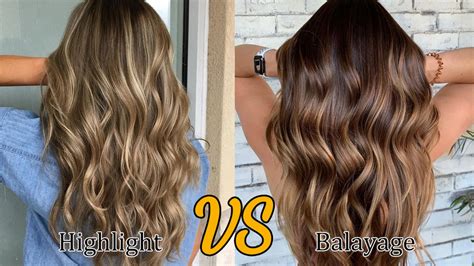Introduction
In the realm of hair coloring, two prominent techniques reign supreme: highlighting and balayage. While both aim to enhance tresses with alluring streaks, they diverge in their application, aesthetic effects, and maintenance requirements. This comprehensive guide will delve into 12 crucial distinctions between highlighting and balayage, empowering you to make an informed decision for your hair transformation journey.

Application Techniques
1. Highlight vs. Balayage Application Technique
- Highlighting: Involves isolating small sections of hair and applying bleach or color directly to them, creating a precisely placed, striped effect.
- Balayage: Employs a freehand painting technique, sweeping color onto the hair’s surface, resulting in a more blended, natural-looking result.
Aesthetic Effects
2. Highlight vs. Balayage Color Placement
- Highlighting: Focuses on creating defined, contrasting streaks that stand out from the base color.
- Balayage: Blends color seamlessly, creating a more subtle, sun-kissed look that mimics natural hair growth.
3. Highlight vs. Balayage Color Intensity
- Highlighting: Typically produces more intense, noticeable highlights due to the direct application of bleach or color.
- Balayage: Offers a softer, more graduated color effect, as the color is blended and diffused throughout the hair.
4. Highlight vs. Balayage Texture
- Highlighting: Creates a more structured, defined texture, with visible stripes of color.
- Balayage: Enhances texture subtly, imparting a natural-looking, beachy effect with blended highlights.
Maintenance Requirements
5. Highlight vs. Balayage Root Touch-Ups
- Highlighting: Requires frequent root touch-ups (every 6-8 weeks) to maintain the sharp contrast between highlighted and uncolored hair.
- Balayage: Offers greater flexibility for root maintenance, with touch-ups needed less frequently (every 12-16 weeks) due to the blended color transition.
6. Highlight vs. Balayage Tone Refresh
- Highlighting: May require periodic toner applications to maintain color vibrancy and prevent brassiness.
- Balayage: Typically does not require regular toning, as the blended color transitions minimize the visibility of fading.
Cost and Time Considerations
7. Highlight vs. Balayage Cost
- Highlighting: Generally more cost-effective than balayage due to the shorter application time and less complex technique.
- Balayage: Involves a more time-consuming, specialized application process, resulting in a higher price point.
8. Highlight vs. Balayage Time
- Highlighting: Requires less application time, usually 2-3 hours.
- Balayage: Can be a more time-intensive process, taking 3-5 hours or longer, depending on hair length and complexity.
Hair Health Impact
9. Highlight vs. Balayage Chemical Damage
- Highlighting: Involves the use of bleach or color applied directly to the hair, which can lead to chemical damage if done excessively.
- Balayage: Minimizes chemical damage as it does not require lifting the hair’s natural color to the same extent as highlighting.
10. Highlight vs. Balayage Hair Breakage
- Highlighting: Over-highlighting can weaken the hair structure, increasing the risk of breakage.
- Balayage: Is less likely to cause hair breakage due to its gentler application technique and reduced chemical exposure.
Motivations and Pain Points
11. Motivation for Highlight vs. Balayage
- Highlighting: Ideal for those seeking a bold, dramatic transformation with contrasting colors and a striking effect.
- Balayage: Perfect for individuals desiring a natural-looking, sun-kissed glow with minimal maintenance and root touch-ups.
12. Pain Point for Highlight vs. Balayage
- Highlighting: May cause more noticeable root growth and require frequent color maintenance.
- Balayage: Can be more expensive and time-consuming than highlighting due to the intricate application process.
Tables for At-A-Glance Comparison
Table 1: Application and Aesthetic Effects
| Feature | Highlighting | Balayage |
|---|---|---|
| Application technique | Foiling or cap | Freehand painting |
| Color placement | Precise, striped | Blended, natural-looking |
| Color intensity | Intense, noticeable | Soft, graduated |
| Texture | Defined, structured | Subtle, beachy |
Table 2: Maintenance Requirements
| Feature | Highlighting | Balayage |
|---|---|---|
| Root touch-ups | Every 6-8 weeks | Every 12-16 weeks |
| Tone refresh | Periodically | Typically not required |
Table 3: Cost and Time Considerations
| Feature | Highlighting | Balayage |
|---|---|---|
| Cost | More cost-effective | Higher price point |
| Time | 2-3 hours | 3-5 hours (or longer) |
Table 4: Hair Health Impact
| Feature | Highlighting | Balayage |
|---|---|---|
| Chemical damage | Higher risk | Lower risk |
| Hair breakage | Increased risk | Decreased risk |
Conclusion
Highlighting and balayage offer distinct hair transformation options, each with its unique advantages and considerations. By understanding the 12 key distinctions explored in this guide, you can determine the technique that best aligns with your aesthetic goals, lifestyle, and hair health priorities. Whether you crave a bold, striking look or a natural-looking, sun-kissed glow, informed decision-making will lead you to the perfect hair coloring solution.
